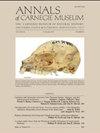A New Species of the Pristimantis conspicillatus Group from the Peruvian Amazon (Anura: Craugastoridae)
IF 0.9
4区 地球科学
Q4 PALEONTOLOGY
引用次数: 6
Abstract
ABSTRACT We name and describe a new species of Anura, Pristimantis iiap, from the lowlands of the Peruvian Amazon, and allocate it to the Pristimantis conspicillatus group (sensu Padial et al. 2014). The new species was collected along the Sepahua River, a small tributary of the Urubamba River (Departamento Ucayali, Peru) running west from the slopes of the Fitzcarrald Arch. Individuals were found active at night in the understory of evergreen lowland forest with high density of bamboo (Guadua spp.). The new species is characterized by having complete and conspicuous dorsolateral folds, a slightly granular belly, a first finger slightly shorter than second, with large discs on fingers and toes (especially Fingers III and IV), a bright orange groin, and by lacking well-defined orange spots on the back of thighs and shanks. The advertisement call is composed of a single pulsed note with an average of 15 pulses/note, a pulse rate of 205 pulses/s, an average call length of 75 ms, and average fundamental and dominant frequencies of 1857 Hz and 3690 Hz, respectively. Pristimantis iiap occurs in sympatry with three other species of the group, P. buccinator (Rodríguez, 1994), P. fenestratus (Steindachner, 1864), and P. skydmainos (Flores and Rodríguez, 1997). Although only known from two close localities, we expect P. iiap to occur in similar forests along the Fitzcarrald Arch and on the eastern slopes of Cordillera Vilcabamba and Cordillera del Sira.秘鲁亚马孙河流域刺青蛛群一新种记述(无尾目:刺青蛛科)
摘要:我们命名并描述了一种新的无尾动物,Pristimantis iiap,来自秘鲁亚马逊低地,并将其分配到Pristimantis illatus组(sensu Padial et al. 2014)。新物种是沿着乌鲁班巴河(秘鲁乌卡亚利省)的一条小支流塞巴华河采集的,这条河从菲茨卡尔德拱门的斜坡向西流淌。在高竹林密度的低地常绿林下发现了夜间活动的个体。这个新物种的特点是有完整而明显的背外侧褶皱,腹部略呈颗粒状,第一根手指略短于第二根手指,手指和脚趾上有大圆盘(尤其是第三和第四根手指),一个明亮的橙色腹股沟,大腿和小腿背部没有明确的橙色斑点。广告呼叫由单个脉冲音符组成,平均15个脉冲/音符,脉冲速率为205脉冲/秒,平均呼叫长度为75毫秒,平均基频和主频分别为1857 Hz和3690 Hz。Pristimantis iiap与该组的其他三个物种,P. buccinator (Rodríguez, 1994), P. fenestratus (Steindachner, 1864)和P. skydmainos (Flores and Rodríguez, 1997)共生。虽然只从两个近距离的地方发现,但我们预计P. iiap会出现在菲茨卡尔德拱门沿线的类似森林中,以及科迪勒拉Vilcabamba和科迪勒拉del Sira的东坡上。
本文章由计算机程序翻译,如有差异,请以英文原文为准。
求助全文
约1分钟内获得全文
求助全文
来源期刊

Annals of Carnegie Museum
综合性期刊-动物学
CiteScore
2.50
自引率
18.20%
发文量
4
审稿时长
>12 weeks
期刊介绍:
Annals of Carnegie Museum is a quarterly journal that publishes peer-reviewed short and medium-length original scientific contributions in organismal biology, earth sciences, and anthropology, in 40 by 52.5 pica format (168 by 220 mm or 6-5/8 by 8-5/8 inches). Subject matter must be relevant to Carnegie Museum of Natural History scientific sections or Powdermill Nature Reserve (PNR), preferably with connection to the Carnegie collection and/or personnel. Carnegie Museum staff and research associates receive publication priority, but others are encouraged to submit papers, especially those manuscripts explicitly based on the Carnegie collection.
 求助内容:
求助内容: 应助结果提醒方式:
应助结果提醒方式:


